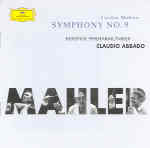Claudio Abbado’s new recording of Mahler’s Ninth Symphony is at once mesmerizing and frustrating. As a performance (recorded live in Berlin in September 1999), it holds its own among the greats in the ever-growing discography of this work, with absolutely riveting, visceral playing from the orchestra in the inner movements, a conscientious eye to structural balance, and pinpoint detail in the dynamics. In a sentence, this performance has it all–except good sound.
For the most part, DG’s engineers have turned a spectacular performance on stage into an uneven experience for the home. The first movement in particular suffers from what seems like “live” experimentation with balances, starting with the first three measures, when the open sound (slight hiss and all) collapses with the appearance of the harp and then re-opens with the sighing entrance in the violins.
Throughout the movement DG’s predilection for close-up miking (a feature of Abbado’s other DG-produced Ninth with the Vienna Philharmonic) creates an unnatural soundstage that emphasizes harp and English horn at the expense of the principal trumpet, which often is drowned out (see instances at measures 38, 232, 365, and 374, and in other places–measure 294–where it is just not prominent enough). Trombones and horns are exaggerated to the point of garishness: the apocalyptic trombone blasts at 314 peal with the force of air horns atop 18-wheelers, and the horns’ raw outbursts would make for another good Maxell ad. Even the orchestra seems as if it’s feeling the piece out: the “Schattenhaft” section is handled too tentatively and the slight ensemble hiccup just before the final large climax disrupts the flow of energy.
After the first-movement trial balloon, the sonic situation improves measurably in the next three movements. In the second and third, the Berliners simply play with stunning drive, and the tight miking here brings out all of Mahler’s creative contrapuntal nuances. The basses barbarically growl out their staccato passages, the trombones and tuba (at 147) thrill with their crude, wild motif, and the bumptious bassoons toward the end of the movement provide great comic relief. The waltz episodes are all appropriately vulgar, and with each repeat Abbado keeps pushing the tempo, as he should. The third movement belongs to Abbado, who tailors the final section (at 522, at the tempo subito) with just the right amount of acceleration so that by the end the orchestra sounds as if it’s ablaze.
Abbado’s conception of the fourth movement–which some conductors have interpreted as a solemn farewell (and thus drag to the point of stasis)–nicely balances the first movement, with almost identical timings (25 minutes). He treats the final movement as a true finale, not as a symphonic fragment, and thus ties the whole of this work into a massive coherent statement. The Berliners do struggle ever so slightly with the pianissimo sections–the flute is too breathy and the strings are undernourished and a touch strident–but on the whole they deliver a passionate performance that never sounds overly sentimental or mushy. There are very few poor performances of Mahler’s Ninth and many excellent ones. This is among the best. Would that it sounded better!
































